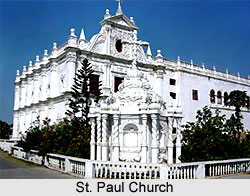 The St. Paul Church is a popular tourist attraction in Goa. It is situated to the south of Church of St. Cajetan on the way from Old Goa to reach Ponda. The church of St. Paul in Goa was constructed by two priests, Diogo de Borba and Miguel Vaz. These two priests had also established the Santa Fe confraternity in India. The construction of the structure had begun in November 1541. It took approximately 2 years to complete its construction which finally concluded in January 1543. The Collegiate Church consecrated on 25 January 1543. This day is also observed as the day of Feast of Conversion of St. Paul. Presently only the facade in the shape of an arch with a niche at the top and a cross crowning it can be seen.
The St. Paul Church is a popular tourist attraction in Goa. It is situated to the south of Church of St. Cajetan on the way from Old Goa to reach Ponda. The church of St. Paul in Goa was constructed by two priests, Diogo de Borba and Miguel Vaz. These two priests had also established the Santa Fe confraternity in India. The construction of the structure had begun in November 1541. It took approximately 2 years to complete its construction which finally concluded in January 1543. The Collegiate Church consecrated on 25 January 1543. This day is also observed as the day of Feast of Conversion of St. Paul. Presently only the facade in the shape of an arch with a niche at the top and a cross crowning it can be seen.
The St. Paul Church was earlier a famous educational institution in India and was considered among the leading educational institutions. Primary education as well as higher education was imparted here. Students could specialise in subjects like Music, Latin, Arts and Sciences. Higher education included a Master`s as well as the Doctorate degree. The St. Paul church was also the first centre to set up the first printing press in Asia. It is credited with printing the first publications. Around the year 1560, this building was demolished and the foundation was laid for a bigger church. Two separate buildings were constructed that were united by a common passage. There was a big library, a hospital as well as a house for people who were converts.
Architecture of St. Paul Church
The structure of St. Paul Church is built of laterite and is lime-plastered, while the columns and the pilasters are of basalt. On either side of the arch is a column of the Corinthian Order on a raised plinth. The arch is supported by pilasters of the Doric Order. It is said that the college was built over the ruins of a mosque. Due to an outbreak of an epidemic in 1570 the building was abandoned. However, it continued for some years as the principal institution of the Jesuits in India. Later there was strong opposition from Augustinians and Nuns of Santa Monica. The building was unfortunately set on fire almost four times by the rivals of Jesuits between 1591 and 1675. The church had the mortal remains of St. Francis Xavier that were preserved in a silver casket. It was later shifted to Basilica of Bom Jesus. In the year 1829, the church was demolished by the government as it was in a complete ruined state. Presently after the demolition the archway and some part of the front entrance still remain on the road that leads to Ponda from Old Goa.





















